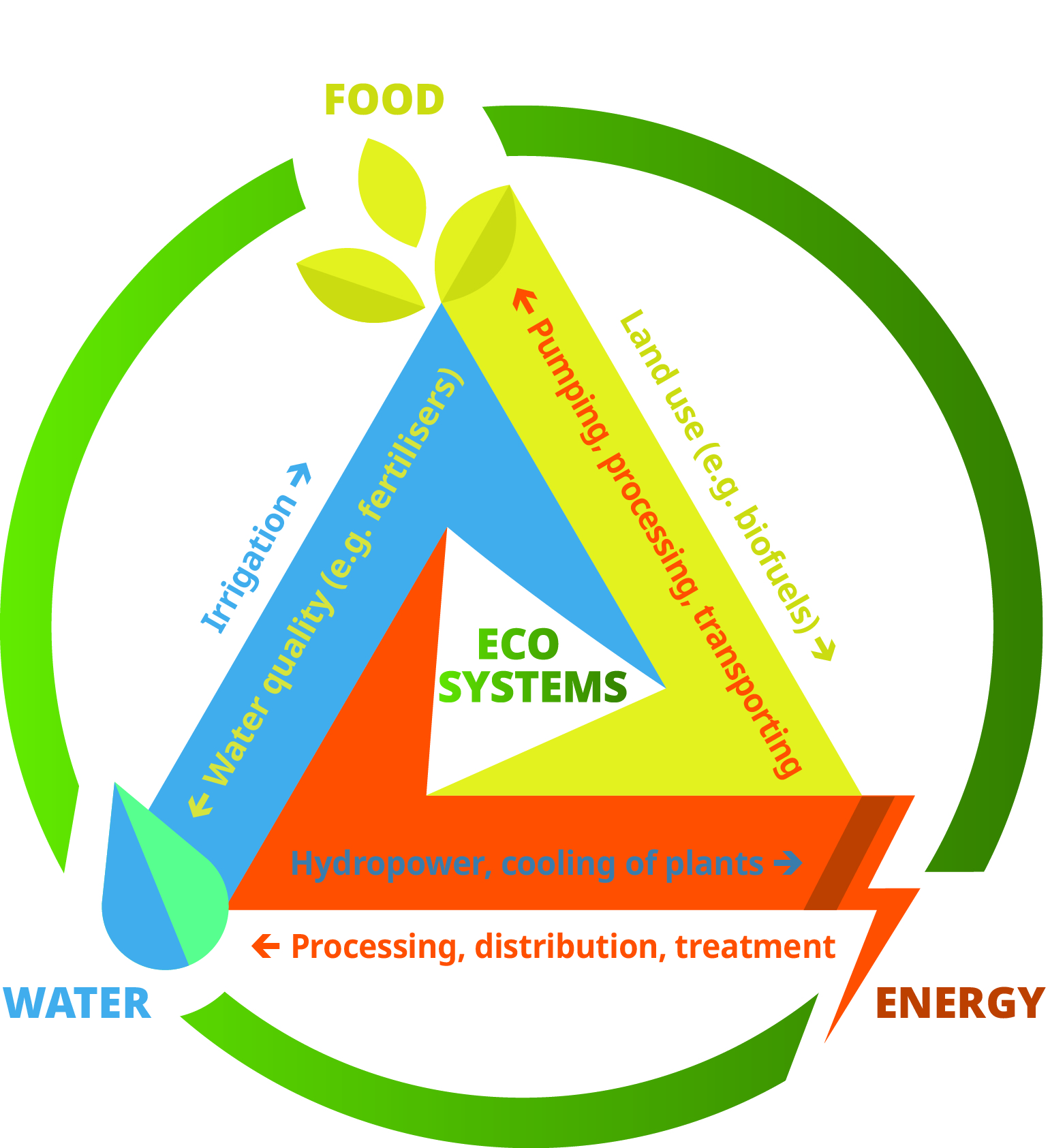Interlinkages between water-energy-food-ecosystems
The Nexus approach stems from the realization that water, energy, agriculture and natural ecosystems exhibit strong interlinkages (see Table 1), and that under a traditional sectoral approach, attempting to achieve resource security independently often endangers sustainability and security in one or more of the other sectors. Under the Nexus approach, interlinkages, synergies and trade-offs are analysed, with the aim of identifying solutions, fostering water-food-energy security and efficiency, and reducing impacts and risks on water-dependent ecosystems.
Table 1: Multi-dimensional interlinkages between water, energy, food and ecosystems
|
Water <-> Energy: Water plays a key role in energy production, e.g. in hydroelectric plants, for cooling thermal (fossil-fuel or nuclear) plants and in growing plants for biofuels. Conversely, energy is required to process and distribute water, to treat wastewater, to pump groundwater and to desalinate seawater. |
|
Water <-> Food: Water is the keystone for the entire agro-food supply chain. Conversely, agricultural intensification impacts water quality. |
|
Food <-> Energy: Energy is an essential input throughout the entire agro-food supply chain, from pumping water to processing, transporting and refrigerating food. Conflicts around land use for food production may arise in the case of biofuels or extended solar installations. |
|
Healthy ecosystems are an essential requirement for the sustainability of all the above and are negatively affected if water, energy or food are used in an unsustainable way. |
Capturing synergies and managing trade-offs
The Nexus approach allows the analysis of interlinkages between sectors, in order to reap positive synergies and to effectively manage trade offs. This is done by adopting an integrated and coordinated approach across sectors, with a view to reconcile potentially conflicting interests, as sectors compete for the same scarce resources, all the while capturing existing opportunities and exploring emerging ones.

Figure 2: The Nexus approach
For example, a large hydropower plant provides benefits by producing electricity, providing water storage for irrigation and urban uses, and mitigating flood effects. However, this can have negative effects for downstream ecosystems and coastal zones, including flooding of agricultural land, or resettling of communities. Similarly, using irrigation to grow biofuel crops can help improve energy security, but it may also compete for land and water resources with agriculture, therefore negatively impacting food security.
Significant opportunities for synergies can arise from such interlinkages. Typical examples include: the potential of wastewater treatment plants to produce energy from biogas and make available treated water for agricultural or environmental uses; installing floating solar panels on reservoirs and using renewable energy for desalination plants.
Benefits of the Nexus approach
The application of a Nexus approach can lead to multiple and cross-sectoral benefits including:
- Economic benefits, such as increased mid- and long-term viability of economic activities, resilience in the face of climate change, reduced risks and associated costs from floods and droughts, greater value added in the agriculture and tourism sectors, increased efficiencies in the consumption of resources and use of infrastructure, and optimized trade and innovation.
- Social and environmental benefits, such as the promotion of the Sustainable Development Agenda 2030, improved public health, employment creation, improved water and sanitation services, improved conservation and the recovery of ecosystems and habitats.
- Regional cooperation and geopolitical benefits, such as enhanced cooperation in the management of shared resources, including the adoption of new cross-border agreements, common regulations and protocols, development of regional markets for goods, services and labour and increased cross-border investments.
In the case of transboundary water bodies, the adoption of the Nexus approach ensures that synergies are explored at both an inter-sectoral and cross-country level, improving coordination, cooperation and thus reducing conflicts and trade-offs. Mutual commitments to increasing resource efficiency and eliminating unnecessary waste of water resources benefits all riparians. A transboundary Nexus approach can also foster regional political cooperation and provide further economic benefits through the development of regional markets and increased and optimized trade.
Effective adoption of the Nexus approach is also a promising instrument for promoting social cross-cutting issues, such as gender empowerment, stakeholder engagement, human rights and combatting poverty, by safeguarding the rights of socially and economically vulnerable groups. These groups are affected the most by resource insecurity, as they depend the most -and spend the largest share of their income- on basic needs in the form of water, food and energy.
